Last week I ordered the Arrow II 146/437-10WBP handheld 2 meter/440 Mhz yagi antenna directly from Arrow Antennas. I also ordered the roll up storage bag with the pockets that is made in the U.S.A. The price for the antenna is $139 and the bag is $40.
This antenna is specifically designed to allow you to work the satellites using an HT, following the satellite through the sky with the antenna in your hand. At first I was a little hesitant to spend that much money on an antenna that could be home-brewed for quite a bit less, but I decided to purchase it because of the ease in which it disassembles, breaks down, and stores away in a small sized package. When you camp in an RV or Jeep, you learn to appreciate products that take up very little storage space.
I was very pleased that I received the antenna very quickly only a few days later. Here is a pic of the antenna taken out of the bag and laid out on the table:
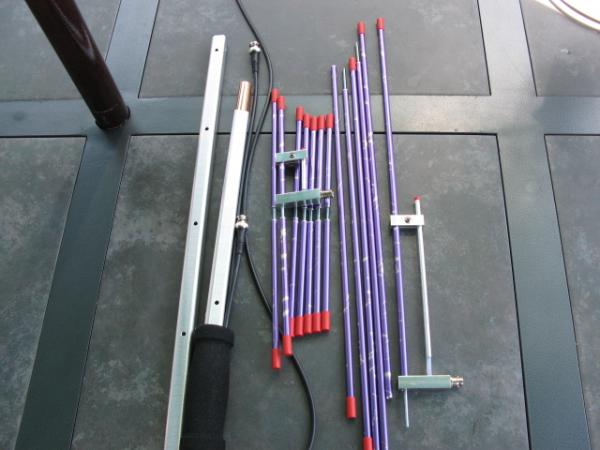
The boom on this model is split with a piece of copper tubing pressed into place and riveted. The copper is a very nice tight fit that ensures that the boom is sturdy when assembled.
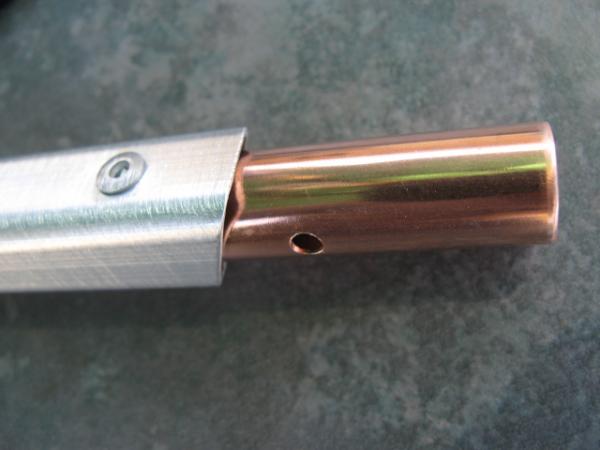
Here is the boom assembled. The overall length of the boom is 37.5"
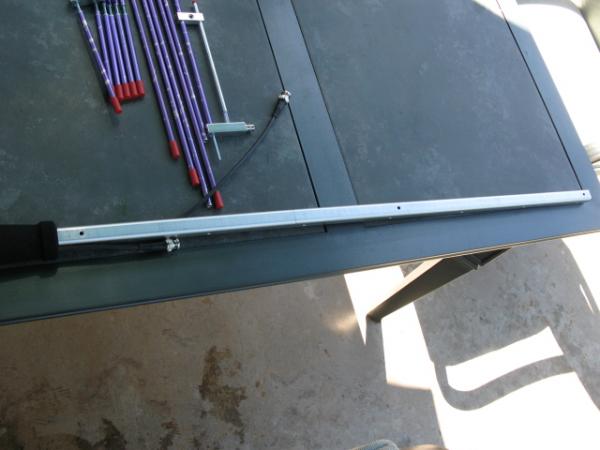
There are no sharp edges on the antenna. All of the edges are rounded and the holes for the elements are deburred
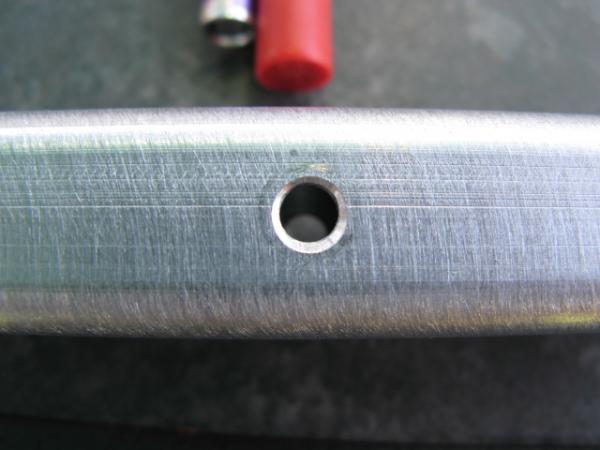
This model also contains a 10 watt 2m/440 duplexer that fits in the handle. You can remove it if you like, by pulling the plastic end cap off. The foam handle goes over the top of the coax that runs up to each driven element.
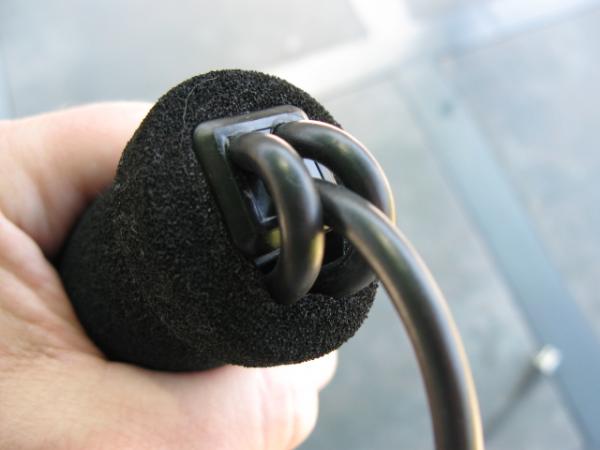
The gamma matches come pre-assembled and tuned for you, although it can be adjusted if desired. This thing is literally "assemble and play". Here is a pic of the 440 Mhz gamma match:
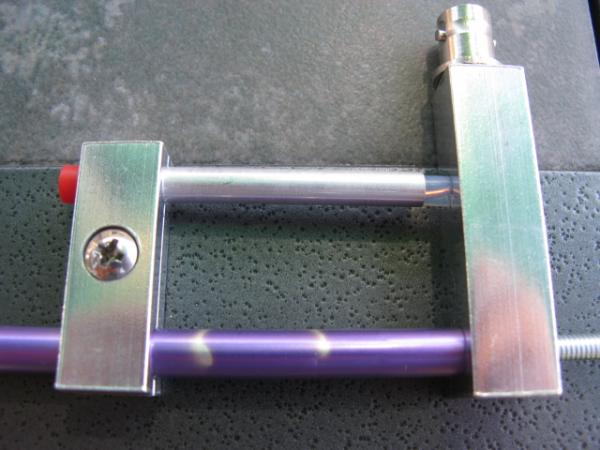
Notice how all of the square edges on the aluminum block of the gamma match are rounded and polished and fit on the round element is perfect. The workmanship on this little antenna is really top quality:
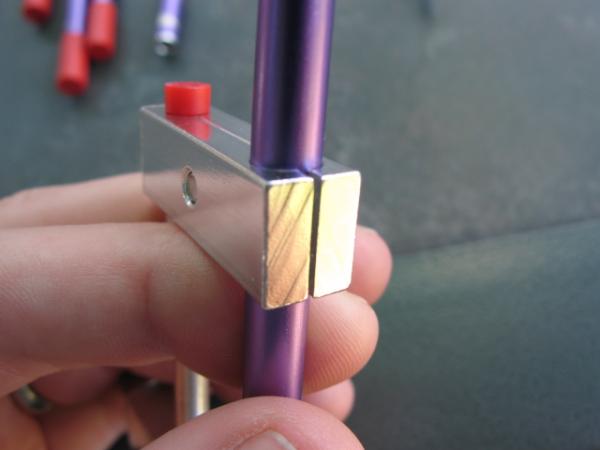
The boom and all of the elements are made of very light weight aluminum. Each of the elements has the female threaded end pressed into the rod. Here is a pic where you can see one of the press marks on the end:
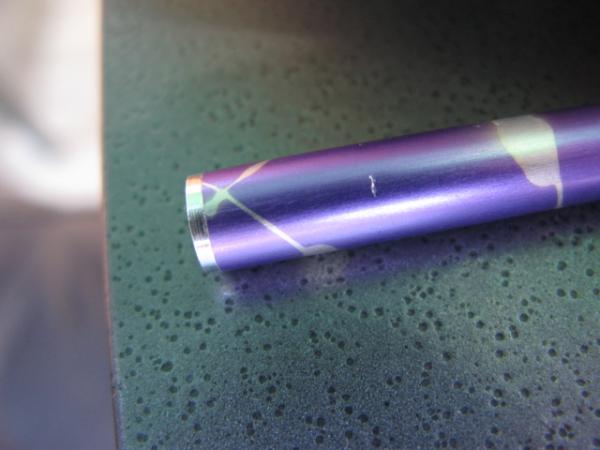
And the female threaded end insert:
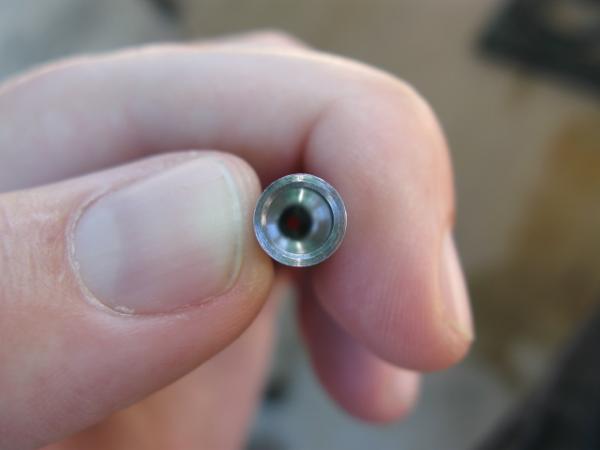
Here is the antenna partially assembled with all of the 2 meter elements:
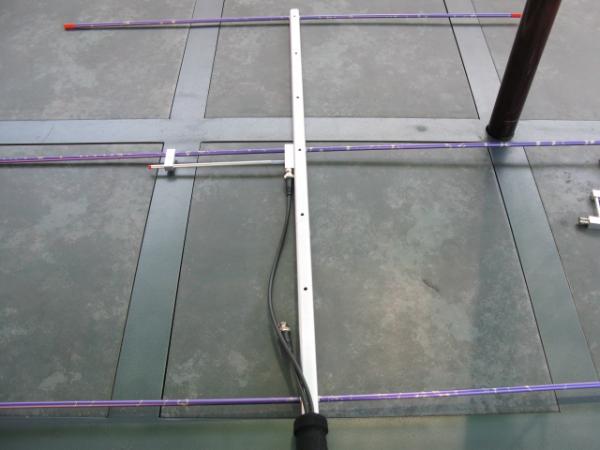
Here is a close up of the antenna fully assembled with all 7 440Mhz elements and the 3 2 meter elements.
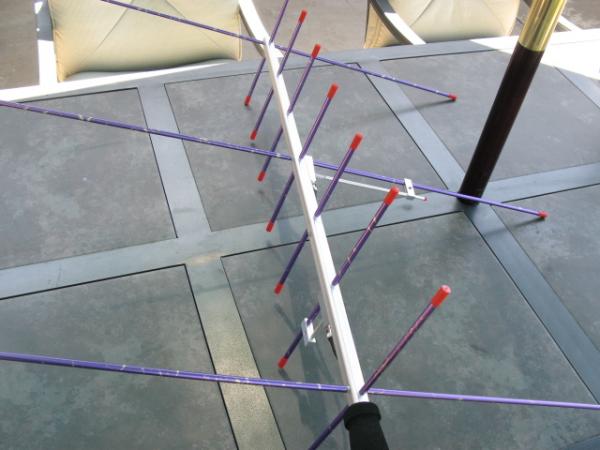
All of the 440 elements come screwed together in the package. This is helpful for the first time you assemble it, becase several are very close in length. Anyone with a basic understanding of how a yagi is built can put this together without even looking at the instructions, although the instructions are well diagrammed if you need the help.
Here is a view looking down the center of the antenna. Note the size and spacing of all of the 440Mhz elements.
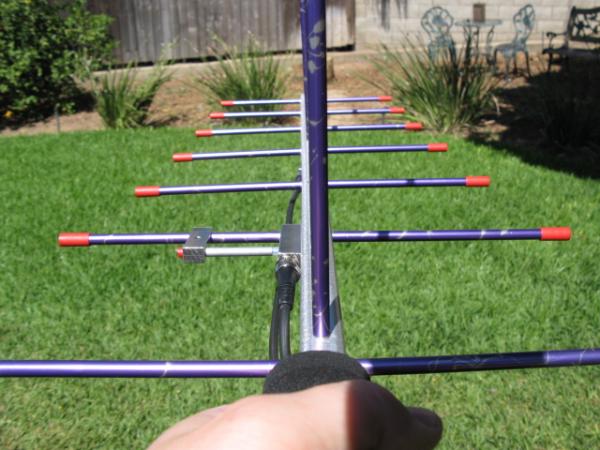
Here is a view of the antenna in the hand looking down the center at both sections. You can see how clean the installation is when fully assembled:
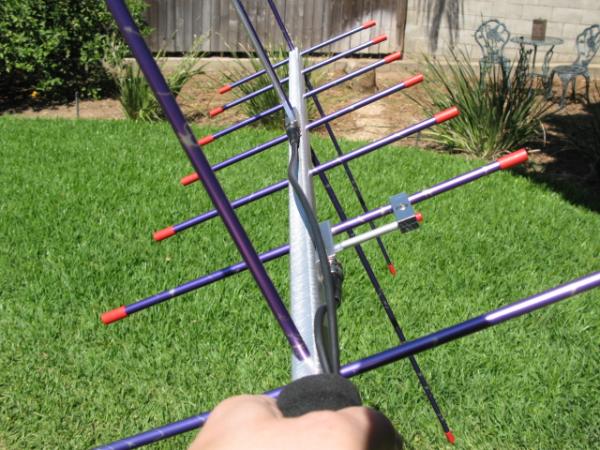
Arrow's advertising repeatedly mentions how lightweight the antenna is. Well, here's proof: Even a kid can hold it up:
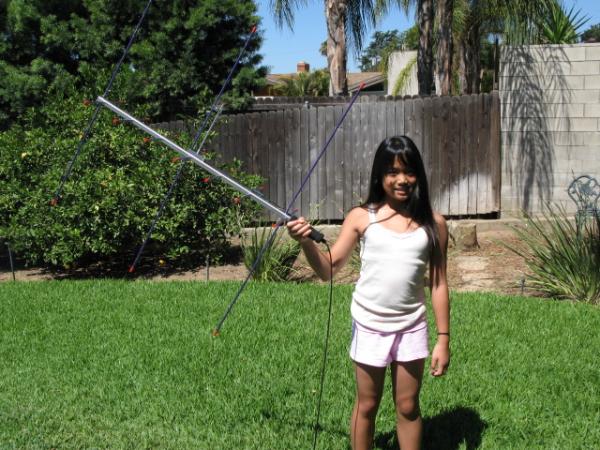
Here is the antenna fully disassembled and stored back in the bag. When storing, it's especially helpful to keep the elements that go to gether stored together. By doing this, I was able to fully assemble the antenna in about 10 minutes while taking my time (and sipping on a beer :tongue: ).
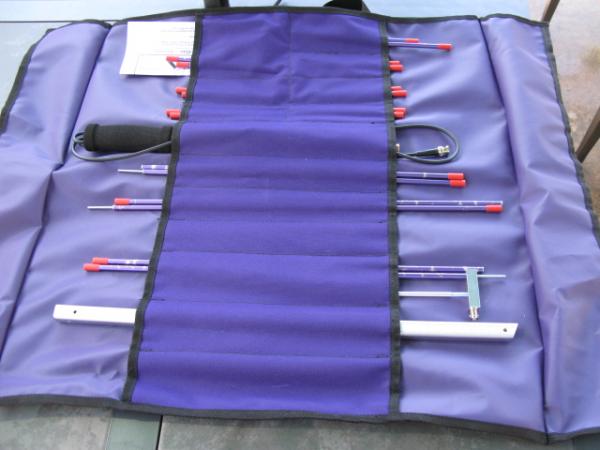
The foam handle on this antenna is removable; it simply slides off the end. This will allow you to use this antenna as a portable base if you so desire with the addition of a square U bolt attached to a small mast on a tripod. Another nice thing about this antenna is that the company has a complete parts list with pricing in case you need to replace any of them. One thing to remember is that you might need a BNC/SMA adapter if your HT uses an SMA antenna. Arrow also sells these if you don't already have one.
I did a quick check with the MFJ-259B analyzer on 2 meters while holding the antenna in my hand (since that is the intended use case scenario). It showed under 2.0:1 SWR bandwidth from 140.5Mhz to 148.93Mhz. The best SWR was 1.2:1 at 146.12 with R=43, X=6. Since my analyzer won't go to 400Mhz, I could only use a basic SWR meter to test that part of the antenna. It showed that the SWR was under 2.0:1 for the entire 440Mhz Amateur band. That is certainly to be expected with elements of this diameter.
Yesterday I used the antenna and made my first HT, handheld antenna satellite contacts with it as A0-51 went over head! Wow, that was fun and challenging! I can tell that I am going to have a blast doing this. I can't wait to try a few other birds and even the ISS.
Overall I'm very impressed and pleased with the quality and design of this antenna. Yes, it is a little pricey, but the convenience of it breaking down coupled with the quality design is worth it to me. Arrow offers a 90 day no questions asked refund if you want to return it for any reason. These are the quality types of Amateur Radio products that I really like to see on the market.
This antenna is specifically designed to allow you to work the satellites using an HT, following the satellite through the sky with the antenna in your hand. At first I was a little hesitant to spend that much money on an antenna that could be home-brewed for quite a bit less, but I decided to purchase it because of the ease in which it disassembles, breaks down, and stores away in a small sized package. When you camp in an RV or Jeep, you learn to appreciate products that take up very little storage space.
I was very pleased that I received the antenna very quickly only a few days later. Here is a pic of the antenna taken out of the bag and laid out on the table:

The boom on this model is split with a piece of copper tubing pressed into place and riveted. The copper is a very nice tight fit that ensures that the boom is sturdy when assembled.

Here is the boom assembled. The overall length of the boom is 37.5"

There are no sharp edges on the antenna. All of the edges are rounded and the holes for the elements are deburred

This model also contains a 10 watt 2m/440 duplexer that fits in the handle. You can remove it if you like, by pulling the plastic end cap off. The foam handle goes over the top of the coax that runs up to each driven element.

The gamma matches come pre-assembled and tuned for you, although it can be adjusted if desired. This thing is literally "assemble and play". Here is a pic of the 440 Mhz gamma match:

Notice how all of the square edges on the aluminum block of the gamma match are rounded and polished and fit on the round element is perfect. The workmanship on this little antenna is really top quality:

The boom and all of the elements are made of very light weight aluminum. Each of the elements has the female threaded end pressed into the rod. Here is a pic where you can see one of the press marks on the end:

And the female threaded end insert:

Here is the antenna partially assembled with all of the 2 meter elements:

Here is a close up of the antenna fully assembled with all 7 440Mhz elements and the 3 2 meter elements.

All of the 440 elements come screwed together in the package. This is helpful for the first time you assemble it, becase several are very close in length. Anyone with a basic understanding of how a yagi is built can put this together without even looking at the instructions, although the instructions are well diagrammed if you need the help.
Here is a view looking down the center of the antenna. Note the size and spacing of all of the 440Mhz elements.

Here is a view of the antenna in the hand looking down the center at both sections. You can see how clean the installation is when fully assembled:

Arrow's advertising repeatedly mentions how lightweight the antenna is. Well, here's proof: Even a kid can hold it up:

Here is the antenna fully disassembled and stored back in the bag. When storing, it's especially helpful to keep the elements that go to gether stored together. By doing this, I was able to fully assemble the antenna in about 10 minutes while taking my time (and sipping on a beer :tongue: ).

The foam handle on this antenna is removable; it simply slides off the end. This will allow you to use this antenna as a portable base if you so desire with the addition of a square U bolt attached to a small mast on a tripod. Another nice thing about this antenna is that the company has a complete parts list with pricing in case you need to replace any of them. One thing to remember is that you might need a BNC/SMA adapter if your HT uses an SMA antenna. Arrow also sells these if you don't already have one.
I did a quick check with the MFJ-259B analyzer on 2 meters while holding the antenna in my hand (since that is the intended use case scenario). It showed under 2.0:1 SWR bandwidth from 140.5Mhz to 148.93Mhz. The best SWR was 1.2:1 at 146.12 with R=43, X=6. Since my analyzer won't go to 400Mhz, I could only use a basic SWR meter to test that part of the antenna. It showed that the SWR was under 2.0:1 for the entire 440Mhz Amateur band. That is certainly to be expected with elements of this diameter.
Yesterday I used the antenna and made my first HT, handheld antenna satellite contacts with it as A0-51 went over head! Wow, that was fun and challenging! I can tell that I am going to have a blast doing this. I can't wait to try a few other birds and even the ISS.
Overall I'm very impressed and pleased with the quality and design of this antenna. Yes, it is a little pricey, but the convenience of it breaking down coupled with the quality design is worth it to me. Arrow offers a 90 day no questions asked refund if you want to return it for any reason. These are the quality types of Amateur Radio products that I really like to see on the market.















